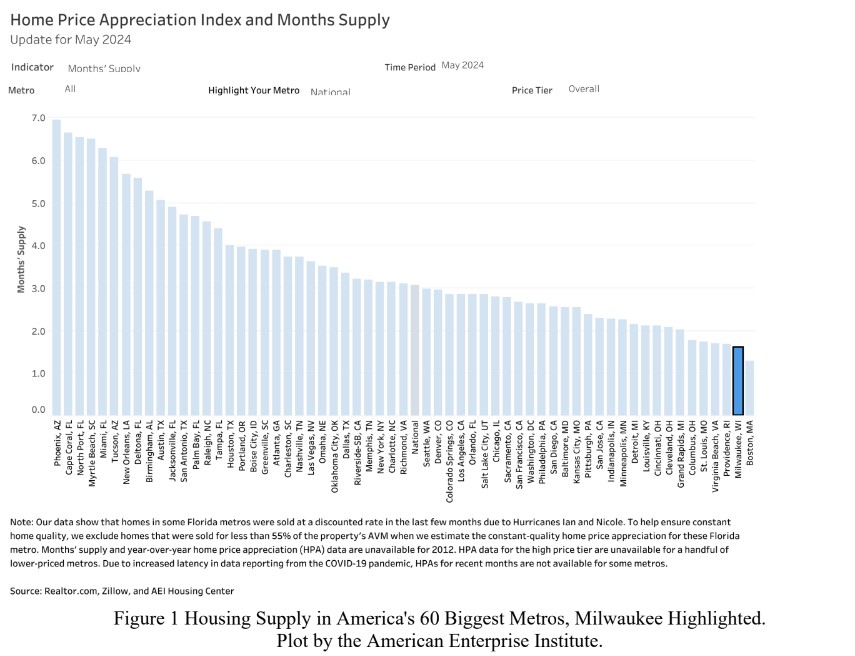This post originally appeared at https://will-law.org/milwaukee-area-housing-market-becoming-more-difficult-for-first-time-homebuyers/
If you read this last week’s Wall Street Journal, you would see that Wisconsin’s housing market is a national focus. WILL’s latest analysis breaks down some of the reasons why.
Key Points:
- The Milwaukee area remains more affordable than the West Coast or the Northeast, and is ranked as the 7th-most affordable nationally for homebuyers.
- The first-time homebuyer in Milwaukee has an average age of 36, a median credit score of 731, and puts down a median down payment of 5%.
- But the area is trending in a more expensive direction, fast: the existing housing stock is appreciating in value rapidly—the Milwaukee area has the nation’s 4th-highest year-over-year increases in price.
- This is fueled by low supply following decades of low construction: the Milwaukee metro area’s housing market has America’s 2nd-lowest supply of homes among major metro areas.
- That housing shortage is manifesting as a problem for renters and people who don’t already own homes in the area: Milwaukee is ranked 16th-worst for renters.
The Milwaukee metro area’s housing market is currently a strong seller’s market—which is tough news for would-be first-time buyers. This is a problem for a region that would like to attract young professionals, make it easier for lower income families to build wealth, and retain residents for generations. In the City of Milwaukee, Mayor Cavalier Johnson hasn’t been shy about his aspirations to reach one million residents, which would require an increase in the city’s housing supply.
Newly available data published by the American Enterprise Institute shows how the Milwaukee metro area’s housing market is, compared to the national background, an increasingly hard one to break into. Milwaukee’s home prices are appreciating rapidly: they posted a 9.14% overall year-over-year rate, which is the 4th-highest among America’s 60 biggest metro areas. Meanwhile, supply is also running low, with Milwaukee having the nation’s 2nd lowest supply among those same 60 areas.

Nationally, today’s first-time homebuyer has a median credit score of 728, a median income of $96,000, a median down payment of 5%, and an average age of 38. The barrier to homeownership is higher compared to 10 years ago, as evidenced by steeper mortgage rates (6.6% compared to 4.0%)—this in spite of better credit scores and today’s median first home having only 93% the square footage.
Another statistic also suggests that nationally buying your first home has become harder: comparing first-time homebuyers’ income to the median income of the area gives an idea of how accessible a housing market is for the people who live there. This stat went up over the past decade, from 92% to 97%.
On the other hand, over the past 10 years, the Milwaukee area has acquitted itself well against national trendlines. The first-time homebuyer here has a slightly lower average age of 36. The median income as a percent of the median area income is only 83% as opposed to 92% nationally, and the median size of a first-bought home, at 1,230 sq. ft., is the same as it was 10 years ago. The median credit score of 731 is nearly identical to the national median of 728, and the down payment median is the same 5% as it is nationally.
All of these Milwaukee-area statistics go hand-in-hand with Milwaukee’s status, compared to the rest of the country, as an affordable place to live and buy a home. A separate AEI ranking places Milwaukee 7th- most affordable for homebuyers out of the country’s 60 biggest metro areas. It remains easier for someone to buy their first home here than in any population center in the Northeast or on the West Coast.
Nevertheless, the housing shortage is hitting would-be buyers in the Milwaukee area especially hard. This is because year-over-year home price appreciation (HPA) in the metro area is not only hot, but hottest in the more affordable tiers: “Low” price-tier homes (i.e. worth $231,000 or less) increased in price by 13.1%, while “Low-Medium” (up to $354,000) homes hit 9.1% and “Medium-High” (up to $958,000) hit 7.2%.
Only the category of “High” suffered a negative HPA, which was typical of that category’s volatile trend lines (and also of least concern to would-be first-time buyers). This makes Milwaukee’s market hotter than any major metro in Texas or Florida, in addition to being ahead of Chicago’s.
In tandem, Milwaukee’s supply is unusually low. Across the nation’s 60 largest metro areas, only Boston had a smaller supply (as measured by months’ supply); all of the other 58 had an ampler supply than Milwaukee’s. For context, although different authorities espouse different rules of thumb, somewhere around five months’ worth of supply is considered “average,” while fewer than that is a “seller’s market.” Milwaukee’s supply was 1.6 months’ worth of housing units; Minneapolis has 2.27 and Chicago has 2.8. Phoenix had the most, at nearly 7 months.

Some of the factors making things challenging for would-be homebuyers are much-covered nationwide woes: high inflation pushed prices higher at the same time that higher interest rates have increased mortgage rates. Still, what’s noteworthy is the shape of Milwaukee’s housing market relative to the rest of the nation. Other metro markets have had to cope with those same macroeconomic issues but have weathered it better, as far as would-be homebuyers are concerned.
Unsurprisingly, a new Forbes study came to similar findings and ranked Milwaukee as the 16th-worst market for renters out of the nation’s 95 biggest cities. Forbes’ analysis prioritized affordability but also took the categories of “availability and amenities” and “lifestyle and safety” into account. By Forbes’ metrics, the two best markets for renters were both in Nebraska (Lincoln and Omaha) followed by examples from the Sun Belt (Raleigh, Austin, and Oklahoma City).
These developments underscore the urgency for policymakers to facilitate construction. As has been said often before, “The most basic fact about the housing crisis is the supply shortage.” Supply is constrained by a variety of governmental systems, from long and uncertain permitting processes to “death by a thousand cuts” regulations that make it impossible to build modestly-sized or affordable units. As one homebuilder put it, “We cannot build a home for a normal family anymore.”
Though housing in Milwaukee has some things going for i —like a higher share of duplexes than any other major American city, and a good share of affordably-sized units Milwaukee, and Wisconsin broadly, have generally dragged their feet when it comes to the creation of new housing.
The aforementioned Phoenix, which has about twice as many people, has created far more units than the city of Milwaukee each year for decades, both in absolute terms and on a per-capita basis (except for 2010, when Phoenix only had slightly more, per-capita). Contrasted with the Lincoln and Omaha, meanwhile, Milwaukee hasn’t permitted more units than either of those cities in any year since 1983, and that’s without adjusting to a per-capita basis.

Noah Diekemper
Senior Research Analyst
Noah@will-law.org
The post Analysis: Milwaukee Area Housing Market Becoming More Difficult for First-Time Homebuyers appeared first on Wisconsin Institute for Law & Liberty.